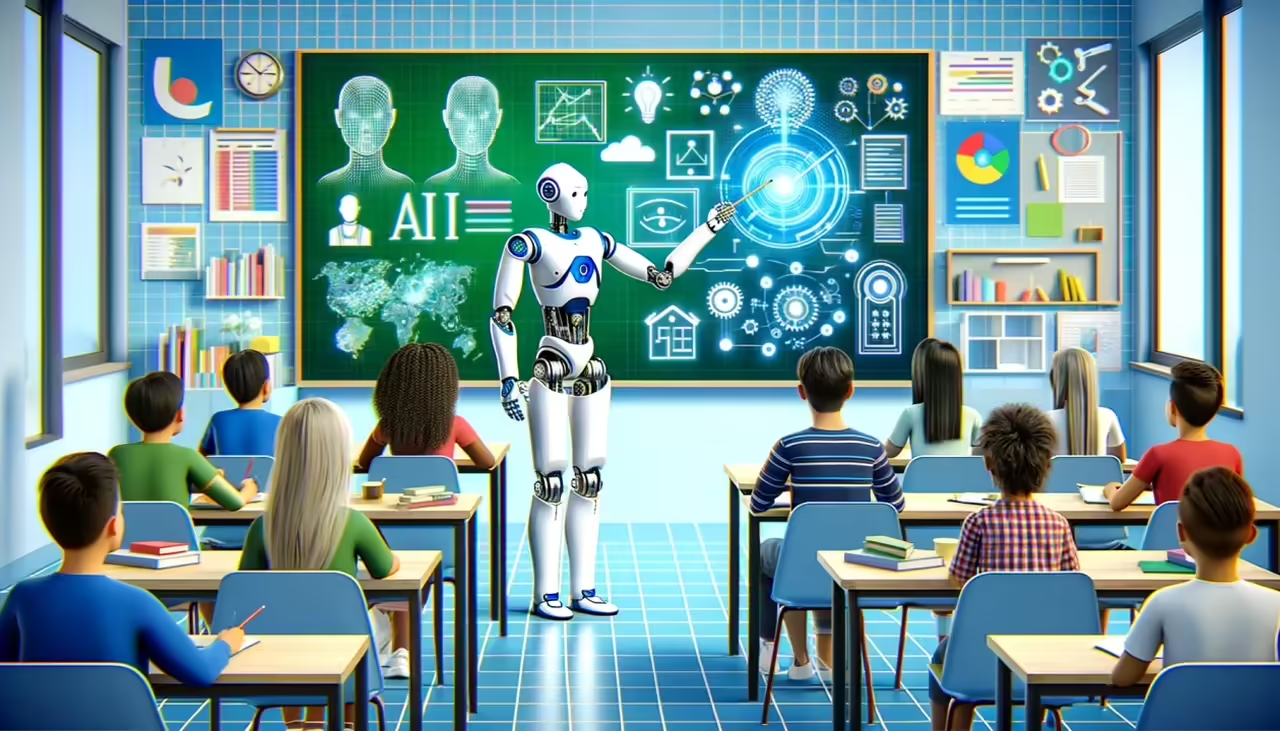
The technological evolution has permeated nearly every aspect of our lives, and the educational realm is no exception. In the current era, marked by digitization and automation, the integration of Artificial Intelligence (AI) in classrooms emerges as an innovative tool with the potential to radically transform the educational process.
AI, understood as the ability of machines to perform tasks requiring human intelligence, has evolved significantly in recent years. From recommendation systems to virtual assistants and machine learning algorithms, AI has demonstrated its capacity to enhance efficiency, personalization, and accessibility across various fields. In the educational context, AI promises to revolutionize the way teaching and learning are conducted.
The integration of AI in classrooms offers numerous advantages. Firstly, it allows for personalized learning tailored to the individual needs of each student. By analyzing data and tracking progress, AI systems can identify students’ strengths and weaknesses, thus providing resources and activities specifically designed to maximize their learning.
Moreover, AI facilitates the creation of more interactive and collaborative educational environments. Chatbots and virtual tutors can provide instant support to students, answering questions and providing immediate feedback. Likewise, AI systems can foster peer collaboration by facilitating communication and idea exchange online.
However, the integration of AI in education also poses challenges and significant ethical considerations. Concerns about data privacy, equity in technology access, and potential algorithmic bias are issues that must be carefully and thoughtfully addressed.
In this context, this work aims to explore the potential impact of AI in classrooms and examine the opportunities and challenges posed by its integration into the educational system. Through detailed and critical analysis, we seek to offer a comprehensive insight into how AI is transforming the future of education and how we can ethically and effectively harness its potential to build an innovative and technological educational future.
The Changing Role of Educators in the Era of Artificial Intelligence
In the era of artificial intelligence (AI), the role of educators is undergoing significant transformation. Traditionally, educators have been the primary facilitators of learning, responsible for imparting knowledge, guiding students, and assessing their progress. However, with the increasing integration of AI in classrooms, the role of educators is evolving into a more dynamic and multifaceted one.
Instead of merely transmitting information, educators now become facilitators of the learning process, leveraging AI tools to personalize the educational experience for each student. AI can help identify students’ individual needs, adapting content and learning activities to meet their abilities, interests, and unique learning styles. As a result, educators need to be trained to effectively utilize these technologies and understand how to meaningfully integrate them into their pedagogical practice.
Furthermore, rather than being the sole providers of knowledge, educators now collaborate with AI systems to enrich learning. Virtual assistants and tutoring systems can provide additional support to students, answering questions, providing feedback, and guiding learning on an individualized basis. This frees up educators to focus on more complex activities and the development of socio-emotional skills such as critical thinking, problem-solving, and collaboration.
However, the role of educators in the era of AI goes beyond simply working alongside these technologies. They must also play an active role in teaching digital skills and promoting digital literacy among their students. This involves not only teaching them to effectively use AI tools but also educating them about the ethical and social aspects related to their use.
Furthermore, educators must be vigilant about the potential side effects of AI integration in education, such as algorithmic bias and loss of data privacy. It is crucial that they are prepared to address these concerns and work in collaboration with other professionals, researchers, and policymakers to ensure that AI is used ethically and equitably in the educational environment.
Potential Benefits of Artificial Intelligence in the Educational Environment
The integration of artificial intelligence (AI) into the educational environment offers a wide range of potential benefits that can significantly transform the way teaching and learning are conducted. These benefits include:
Personalized Learning: AI enables the adaptation of educational content and learning activities to the individual needs of each student. By analyzing data on students’ progress and learning preferences, AI systems can offer personalized educational experiences that maximize learning effectiveness.
Access to Advanced Educational Resources: AI can provide access to a wide variety of educational resources, including online learning materials, interactive tutorials, and virtual simulations. This expands learning opportunities beyond the physical limits of the classroom and provides students with access to high-quality educational content anytime, anywhere.
Personalized Support and Feedback: AI systems can offer personalized support to students, answering questions, providing feedback on progress, and offering personalized recommendations to improve learning. This helps students progress at their own pace and overcome obstacles more efficiently.
Automation of Administrative Tasks: AI can automate a variety of administrative tasks in the educational field, such as grading exams, managing student records, and scheduling classes. This frees up time for educators to focus on more creative and interactive teaching activities.
Facilitation of Collaboration and Social Learning: AI systems can foster collaboration among students by facilitating online communication, creating study groups, and collaborating on projects. Additionally, they can analyze data on student interaction to identify social learning opportunities and promote a collaborative educational environment.
Early Identification of Learning Problems: AI can analyze data on students’ performance and behavior to identify potential learning problems early on. This allows educators to intervene quickly and provide the necessary support to ensure the academic success of all students.
Successful Case Studies: How Some Institutions Have Adopted AI in Education
Several successful case studies illustrate how various educational institutions have adopted artificial intelligence (AI) to improve teaching and learning. Here are some notable examples:
Knewton at Nanyang Technological University (NTU), Singapore: Nanyang Technological University (NTU) in Singapore collaborated with Knewton, an educational technology company that uses AI to personalize learning. Using Knewton’s system, NTU was able to adapt curricula and learning materials to meet the individual needs of each student. This resulted in a significant improvement in academic outcomes, with higher student passing and retention rates.
Georgia State University, United States: This university implemented an AI system called “Panther Retention Grant Analytics,” which uses machine learning algorithms to identify students at risk of dropping out. The system analyzes academic and demographic data to identify patterns and risk factors, allowing the university to intervene with personalized support measures to improve student retention. Thanks to this initiative, the student retention rate has increased significantly.
Squirrel AI Learning, China: Squirrel AI Learning is an online education platform that uses AI to provide personalized math instruction. Using machine learning algorithms, the platform assesses each student’s competency level and adjusts the content and difficulty of exercises accordingly. This has been shown to significantly improve students’ academic performance, with some reports showing increases of up to 80% in test scores.
Project LISTEN at Carnegie Mellon University, United States: Project LISTEN (Literacy Innovation that Speech Technology ENables) is a research project at Carnegie Mellon University that uses AI to improve children’s literacy. The project developed a virtual reading tutor called the “Reading Tutor,” which uses speech recognition technology and adaptive feedback to help children improve their reading skills. The results have been promising, with significant improvements in reading speed and comprehension among participating children.
Tools and Resources Available for Integrating Artificial Intelligence in Teaching
The integration of artificial intelligence (AI) in teaching benefits from a variety of tools and resources available that can help educators make the most of this technology. Here are some highlighted options:
Adaptive Learning Platforms: Platforms like Knewton, DreamBox Learning, and Duolingo use AI algorithms to personalize learning
based on each student’s individual needs. These platforms can adapt content, exercises, and learning activities to optimize student progress.
Educational Virtual Assistants and Chatbots: Tools such as IBM Watson Assistant, Google Dialogflow, and Microsoft Azure Bot Service enable educators to create customized virtual assistants and chatbots to provide instant support and answer students’ questions.
Educational Data Analytics Platforms: Platforms like BrightBytes and Learnmetrics offer advanced data analytics to help educators better understand student performance and progress. These tools can identify patterns, trends, and areas for improvement, facilitating informed decision-making about teaching and learning.
Educational Content Creation Tools: Platforms like Cognii and Quillionz use AI to assist educators in creating high-quality educational content, such as assessment questions and learning materials. These tools can automatically generate questions and answers based on text, images, or videos.
Virtual Tutoring Platforms: Platforms like Socratic and TutorOcean offer AI-driven virtual tutoring services, where students can receive individualized support from virtual tutors in a variety of subjects and topics.
Educational Resource Recommendation Systems: Platforms like Edmodo and Kiddom use AI algorithms to recommend relevant educational resources, such as books, videos, and apps, based on students’ needs and interests.
Automatic Assessment Tools: Platforms like Gradescope and Turnitin use AI to facilitate automatic assessment of assignments and exams, saving educators time and providing quick and accurate feedback to students.
These are just some of the many tools and resources available for integrating AI into teaching. By exploring and leveraging these options, educators can enhance the efficiency, personalization, and effectiveness of their pedagogical practice, creating more enriching and meaningful learning experiences for students.
Preparing Students for an AI-Driven Future: New Skills and Competencies
Preparing students for an AI-driven future involves equipping them with a diverse set of skills and competencies that enable them to adapt and thrive in an ever-changing work and social environment. Here are some key skills that educators can focus on developing:
Critical Thinking and Problem-Solving: Students should be able to critically analyze information, evaluate the validity of arguments, and make informed decisions. This includes the ability to identify and solve problems creatively, using logic and deductive and inductive reasoning.
Digital Literacy: Students should be familiar with digital technologies and be able to use software tools and online platforms effectively. This includes skills in basic programming, data handling, safe web browsing, and understanding concepts of AI and machine learning.
Lifelong Learning: Since technology and the job market are constantly evolving, it is crucial for students to develop a lifelong learning mindset. They should be willing to acquire new skills and knowledge throughout their lives and be able to adapt to new environments and challenges.
Emotional Intelligence and Social Skills: As AI automates many technical tasks, human skills such as empathy, effective communication, and teamwork become even more important. Students should learn to develop strong interpersonal relationships, collaborate with others, and manage conflicts constructively.
Creativity and Innovative Thinking: In an AI-driven world, creativity and the ability to think innovatively become key assets. Students should be encouraged to explore new ideas, take risks, and develop original solutions to complex problems.
Ethics and Digital Responsibility: With the rise of automation and algorithm use, it is essential for students to understand the ethical and social implications of AI. They should be aware of issues such as algorithmic bias, data privacy, and equity in technology access, and be able to make informed ethical decisions in a digital world.
By focusing on the development of these skills and competencies, educators can prepare students to succeed in an AI-driven future, where the ability to adapt, learn, and collaborate will be more important than ever.







